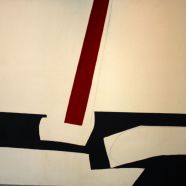Going t/here with Vincencia Blount
- Lord Acton was Wrong
- Fortune’s Folly
- Timespan
What guide does one use to traverse through a city, a forest, or even a space beyond comprehension? We try to read a map to find direction―using the stars, maybe a folded travel map, or some sort of global positioning system. We seek what seems to be a definitive path, often getting quietly lost in the process. Eventually a destination appears, our locus. The way there could follow a horizontal course, or it may traverse over hills, up stories, moving vertically through the landscape. With a folded map we experience flattened dimensions of landscape to perceive our endpoint from the eye of God. A compass rose places us within the cardinal directions, allowing us to sense the curve of the earth. I think of Çatalhöyük, an ancient city in modern-day Turkey, where the inhabitants built homes on top of each other, stacked so tight and high that people would enter through the ceilings. Their sense of up and down must have been magical.
The artist Vincencia Blount, known as Tatty to her friends, created drawings informed by ancient and imagined places. Like a mapmaker, she took an abstraction and organized it to make it visually relatable. Blount was born in Florida in 1924 and died in Atlanta in 2012, where she lived most of her days, making artwork well into her eighties. She was bold and prolific, exhibiting in the South and New York at a time when art by women was often not considered worthy of wall space. She was recognized as being a part of a nationally respected stable of artists presented by Judith Alexander, one of the vibrant founders of Atlanta’s contemporary and folk art scenes.
An avid traveler, Blount was fascinated by ancient cultures. Curator and art historian David Houston, who helped organize a 2004 retrospective of Blount’s work at the Ogden Museum of Southern Art in New Orleans, wrote of “her love of pre-Columbian cities and other urban sites. She would look at archeological plans/maps of the sites, many of them she personally visited, and transform them into elegant abstract color field paintings.”1 Her exploration of the caves of Lascaux in southwestern France, where cave walls are covered with some of the oldest paintings known to humans, was pivotal.2
Blount’s artwork is dynamic in attitude and ideas. Her sensibility is expressed through her intellectual approach to abstraction. Brush strokes, bleeds, and splashes on canvas, overlapping textures with a brilliant sense of color relationships make her large oil paintings seem like broad worlds to fall into. Her works on paper are contemplative, meditative, and minimal. She used highly pigmented liquid media to carve out spaces on paper, often with a remnant of a light pencil line documenting her earlier thoughts. The relationship of shape and space is always primary, as expressed in Lord Acton was Wrong. Blount’s loose plots of negative and positive shapes play off of each other. The tension between the open areas where the paper has a voice and the darker, graceful shapes, as seen in Timespan, creates a palpable sense of space. Fortune’s Folly has organic and geometric shapes butted up against each other, as though we are hovering over the city plan for the surroundings of a Mesoamerican stepped pyramid. One can feel a pulsing heat—possibly from the Atlanta landscape, or from lands further south. When I look intensely at her work I feel as if my footing on the earth is being loosened. I look from above to simultaneously peek in from the side. I see a city, or prehistoric stone and mud constructions. This contrast and the abstraction allow me to lose myself in the deceivingly simple and timeless spatial relationships that Blount has built.
Many people maneuver fluidly through a place with no questions. Others stumble into the strata of a landscape, running their thoughts along the edges to explore boundaries and seek answers. They may design a new history for the place as Richard McGuire did in his graphic novel Here. McGuire draws the same site during numerous time periods, from the days of dinosaurs through current times. He depicts mainly mundane happenings, organizing them with no logical chronology. The static location here becomes a continuum, with living beings moving in and out of the picture plane. Blount’s work reminds me of this, where her artwork comes together, a study of never-ending perspectives from one significant place, always keeping hold of or expressing her own complex mapping of inspiration and self.
Notes:
- Houston, David. Email message to Lisa Alembik. 16 August 2016.
- Fox, Cathy, “New Orleans show honors Atlantan.” Atlanta Journal Constitution. 22 Feb. 2004: L1, L6.
*All photographs of the artwork courtesy of the Ogden Museum of Southern Art.











The thought came to me, seeing these works, that the artist was sort of doing sculpture with paint-on-paper, beautiful flat sculpture, which instead of being able to walk around one is drawn into.
Anyway, I would have loved to ask her how and why Lord Acton was wrong.